Simulation Study on Gas Leakage Law and Early Warning in a Utility Tunnel
Abstract
:1. Introduction
2. Construction of a Comprehensive Pipeline Corridor Gas Simulation Model
2.1. Physical Model Construction
2.2. Calculation of Steady Leakage Rate of Gas Pipeline in Utility Tunnel
- (1)
- As shown in Figure 4, point “A” is a point far away from the leakage port, but the gas leakage speed is usually fast and there is not enough time to exchange heat with the environment. Therefore, point “A” to point “B” can be considered an adiabatic flow process of ideal gas.
- (2)
- From point “A” to point “B”, there is only one main pipe and no other gas flow outlet. The air pressure of urban gas is mostly below 1.6 MPa and the temperature is normal temperature. Therefore, the flow, pressure, and flow rate of the sections at point “A” and point “B” are not affected by the leakage outlet at all and satisfy the ideal gas state equation:
- (3)
- According to The Urban Gas Design standards in China, when the nominal diameter of the gas pipeline in the comprehensive pipe corridor is DN200–300 mm, its corresponding wall thickness is 4.8 mm. The leakage process can be regarded as an adiabatic process due to the thin pipe wall and the high flow rate of the gas jet.
2.3. Calculation of the Steady-State Leakage Time of the Gas Pipeline in the Utility Tunnel
2.4. Grid Division
2.5. Irrelevance Test of the Grid
2.6. Model Solving
3. Fluent Calculation Settings
3.1. Setting Up the Solver
3.2. Setting of Boundary Conditions
4. Study on the Diffusion Radius of Gas Leaks in Utility Tunnels
4.1. Graph of the Gas-Leak Radius over Time
4.2. Influence of Leak-Hole Diameter on Diffusion Radius
4.3. Early Warning Study of the Gas Cabin in Utility Tunnels
5. Conclusions
- (1)
- When gas leakage occurs from the gas pipeline of the utility tunnel, it is a dynamic process. Starting from 0 s, gas leaks from the hole and then peaks at 0.011989247 in a very short time. At 0–30 s, the peak value of gas leakage remains unchanged, and the leakage radius gradually increases. In addition, at 30–120 s, the gas concentration remains unchanged in two sections on the left and right sides of the leak. When the leakage time is within 0–80 s, the leakage law is symmetrical around the leakage point. However, after 80 s, the gas leakage law is no longer symmetrical around the leakage point. This is because the left side of the leak hole is closer to the air inlet and the right side is closer to the air outlet. The air flow will force the leaked gas to quickly gather downstream.
- (2)
- When the ventilation system of the gas cabin is natural ventilation without accidents, if a leakage accident occurs, even 12 ventilation operations per hour cannot guarantee that the gas concentration in the cabin is lower than 20 percent of the lower explosion limit. Therefore, the gas cabin must maintain daily mechanical ventilation at least 6 times per hour. This ventilation model has also become a more scientific and safe ventilation method for utility tunnels and provides a certain theoretical basis for the development of subsequent safety specifications.
- (3)
- Considering economic factors and ensuring that the ventilation system can effectively discharge the leaked gas out of the cabin in time, the optimal arrangement distance of the sensors in the gas cabin of the utility tunnel is approximately 10 m, and the sensor alarm concentration should be set to the gas explosion lower limit of 20 percent. By arranging sensors in the way of this paper, utility tunnel managers can maximize cost savings and avoid unnecessary waste while ensuring safety.
Author Contributions
Funding
Institutional Review Board Statement
Informed Consent Statement
Data Availability Statement
Acknowledgments
Conflicts of Interest
References
- Canto-Perello, J.; Curiel-Esparza, J. Assessing governance issues of urban utility tunnels. Tunn. Undergr. Space Technol. 2013, 33, 82–87. [Google Scholar] [CrossRef]
- Cano-Hurtado, J.; Canto-Perello, J. Sustainable development of urban underground space for utilities. Tunn. Undergr. Space Technol. 1999, 14, 335–340. [Google Scholar] [CrossRef]
- Wang, T.Y.; Tan, L.X.; Xie, S.Y.; Ma, B.S. Development and applications of common utility tunnels in China. Tunn. Undergr. Space Technol. 2018, 76, 92–106. [Google Scholar] [CrossRef]
- Canto-Perello, J.; Curiel-Esparza, J.; Calvo, V. Strategic decision support system for utility tunnel’s planning applying A’WOT method. Tunn. Undergr. Space Technol. 2016, 55, 146–152. [Google Scholar] [CrossRef]
- Canto-Perello, J.; Curiel-Esparza, J. Risks and potential hazards in utility tunnels for urban areas. Proc. Inst. Civil Eng.-Munic. Eng. 2003, 156, 51–56. [Google Scholar] [CrossRef]
- Cai, Q.J.; Hu, Q.J.; Ma, G.L. Improved Hybrid Reasoning Approach to Safety Risk Perception under Uncertainty for Mountain Tunnel Construction. J. Constr. Eng. Manag. 2021, 147, 04021105. [Google Scholar] [CrossRef]
- Ma, L.; Bin Luo, H.; Chen, H.R. Safety risk analysis based on a geotechnical instrumentation data warehouse in metro tunnel project. Autom. Constr. 2013, 34, 75–84. [Google Scholar] [CrossRef]
- Zhang, G.D.; Shi, M.X. Bayesian assessment of utility tunnel risk based on information sharing mechanism. J. Intell. Fuzzy Syst. 2021, 41, 4749–4757. [Google Scholar] [CrossRef]
- Kim, Y.A.; Ryoo, B.Y.; Kim, Y.S.; Huh, W.C. Major Accident Factors for Effective Safety Management of Highway Construction Projects. J. Constr. Eng. Manag. 2013, 139, 628–640. [Google Scholar] [CrossRef]
- Jiang, Y.J.; Zhang, X.P.; Taniguchi, T. Quantitative condition inspection and assessment of tunnel lining. Autom. Constr. 2019, 102, 258–269. [Google Scholar] [CrossRef]
- Zhang, L.M.; Wu, X.G.; Liu, H.T. Strategies to Reduce Ground Settlement from Shallow Tunnel Excavation: A Case Study in China. J. Constr. Eng. Manag. 2016, 142, 04016001. [Google Scholar] [CrossRef]
- Liu, C.; AbouRizk, S.; Morley, D.; Lei, Z. Data-Driven Simulation-Based Analytics for Heavy Equipment Life-Cycle Cost. J. Constr. Eng. Manag. 2020, 146, 04020038. [Google Scholar] [CrossRef]
- Arabi, S.; Eshtehardian, E.; Shafiei, I. Using Bayesian Networks for Selecting Risk-Response Strategies in Construction Projects. J. Constr. Eng. Manag. 2022, 148, 04022067. [Google Scholar] [CrossRef]
- Pilao, R.; Ramalho, E.; Pinho, C. Explosibility of cork dust in methane/air mixtures. J. Loss Prev. Process Ind. 2006, 1, 17–23. [Google Scholar] [CrossRef]
- Bauwens, C.R.; Chaffee, J.; Dorofeev, S. Effect of ignition location, vent size and obstacles on vented explosion overpressures in propane-air mixtures. Combust. Sci. Technol. 2010, 182, 1915–1932. [Google Scholar] [CrossRef]
- Qian, H.M.; Li, J.; Zong, Z.H.; Wu, C.Q.; Pan, Y.H. Behavior of precast segmental utility tunnel under ground surface Explosion: A numerical study. Tunn. Undergr. Space Technol. 2021, 115, 104071. [Google Scholar] [CrossRef]
- Fan, C.G.; Chen, J.; Zhou, Y.; Liu, X.P. Effects of fire location on the capacity of smoke exhaust from natural ventilation shafts in urban tunnels. Fire Mater. 2018, 42, 974–984. [Google Scholar] [CrossRef]
- Yang, C.; Peng, F.L. Discussion on the development of underground utility tunnels in China. Procedia Eng. 2016, 165, 540–548. [Google Scholar] [CrossRef]
- Li, P.F.; Xu, M.Y.; Wang, F.F. Proficient in CFD Engineering Simulation and Case Study; The Posts and Telecommunications Press: Beijing, China, 2011; ISBN 9787115260802. [Google Scholar]
- Al-Bataineh, M.; AbouRizk, S.; Parkis, H. Using Simulation to Plan Tunnel Construction. J. Constr. Eng. Manag. 2013, 139, 564–571. [Google Scholar] [CrossRef]
- Yan, Q.S.; Zhang, Y.N.; Sun, Q.W. Characteristic Study on Gas Blast Loadings in an Urban Utility Tunnel. J. Perform. Constr. Facil. 2020, 34, 04020076. [Google Scholar] [CrossRef]
- Ouyang, M.; Liu, C.; Wu, S.Y. Worst-case vulnerability assessment and mitigation model of urban utility tunnels. Reliab. Eng. Syst. Saf. 2020, 197, 106856. [Google Scholar] [CrossRef]
- Lin, Z.Z.; Guo, C.C.; Ni, P.P.; Cao, D.F.; Huang, L.; Guo, Z.F.; Dong, P. Experimental and numerical investigations into leakage behaviour of a novel prefabricated utility tunnel. Tunn. Undergr. Space Technol. 2020, 104, 103529. [Google Scholar] [CrossRef]
- Yin, Z.Y.; Wang, P.; Zhang, F.S. Effect of particle shape on the progressive failure of shield tunnel face in granular soils by coupled FDM-DEM method. Tunn. Undergr. Space Technol. 2020, 100, 103394. [Google Scholar] [CrossRef]
- Wang, P.; Karatza, Z.; Arson, C. DEM modelling of sequential fragmentation of zeolite granules under oedometric compression based on XCT observations. Powder Technol. 2019, 347, 66–75. [Google Scholar] [CrossRef]
- Zhang, H.T.; Zhao, Y.F. Study on Underground Utility Tunnel Fire Characteristics under Sealing and Ventilation Conditions. Adv. Civ. Eng. 2020, 2020, 9128704. [Google Scholar] [CrossRef]
- Mi, H.F.; Liu, Y.L.; Jiao, Z.R.; Wang, W.H.; Wang, Q.S. A numerical study on the optimization of ventilation mode during emergency of cable fire in utility tunnel. Tunn. Undergr. Space Technol. 2020, 100, 103403. [Google Scholar] [CrossRef]
- Tang, G.Y.; Fang, Y.M.; Zhong, Y.; Yuan, J.; Ruan, B.; Fang, Y.; Wu, Q. Numerical Study on the Longitudinal Response Characteristics of Utility Tunnel under Strong Earthquake: A Case Study. Adv. Civ. Eng. 2020, 2020, 8813303. [Google Scholar] [CrossRef]
- Yang, Y.M.; Li, Z.G.; Li, Y.Q.; Xu, R.; Wang, Y.K. Research on the anti-seismic performance of composite precast utility tunnels based on the shaking table test and simulation analysis. Comput. Concr. 2021, 27, 163–173. [Google Scholar]
- Wang, W.H.; Zhu, Z.X.; Jiao, Z.R.; Mi, H.F.; Wang, Q.S. Characteristics of fire and smoke in the natural gas cabin of urban underground utility tunnels based on CFD simulations. Tunn. Undergr. Space Technol. 2021, 109, 103748. [Google Scholar] [CrossRef]
- Zhao, Y.C.; Zhu, G.Q.; Gao, Y.J. Experimental study on smoke temperature distribution under different power conditions in utility tunnel. Case Stud. Therm. Eng. 2018, 12, 69–76. [Google Scholar]
- Bu, F.X.; Liu, Y.; Wang, Z.X.; Xu, Z.; Chen, S.Q.; Hao, G.W.; Guan, B. Analysis of natural gas leakage diffusion characteristics and prediction of invasion distance in utility tunnels. J. Nat. Gas Sci. Eng. 2021, 96, 104270. [Google Scholar] [CrossRef]
- Kunii, D.; Levenspiel, O. Fluidization Engineering; Butterworth-Heinemann: Boston, MA, USA, 1962; ISBN 0409902330. [Google Scholar]
- Montiel, H.; Vilchez, J.A.; Casal, J.; Arnaldos, J. Mathematical modeling of accidental gas release. J. Hazard. Mater. 1998, 59, 211–233. [Google Scholar] [CrossRef]
- Woodward, J.L.; Mudan, K.S. Liquid and gas discharge rates through holes in process vessels. J. Loss Prev. Proc. 1991, 4, 161–165. [Google Scholar] [CrossRef]
- GB50838-2015; Technical Specification for Urban Utility Tunnel Engineering. Standardization Administration of the People’s Republic of China: Beijing, China, 2015.
- GB/T50028-2006; Code for design of city gas engineering. Standardization Administration of the People’s Republic of China: Beijing, China, 2006.
- GB50493-2009; Specification for Design of Combustible Gas and Toxic Gas Detection and Alarm for Petrochemical Industry. Standardization Administration of the People’s Republic of China: Beijing, China, 2009.
- GB51274-2017; Technical Standard for Monitoring and Alarm System Engineering for Urban Utility Tunnel Engineering. Standardization Administration of the People’s Republic of China: Beijing, China, 2017.

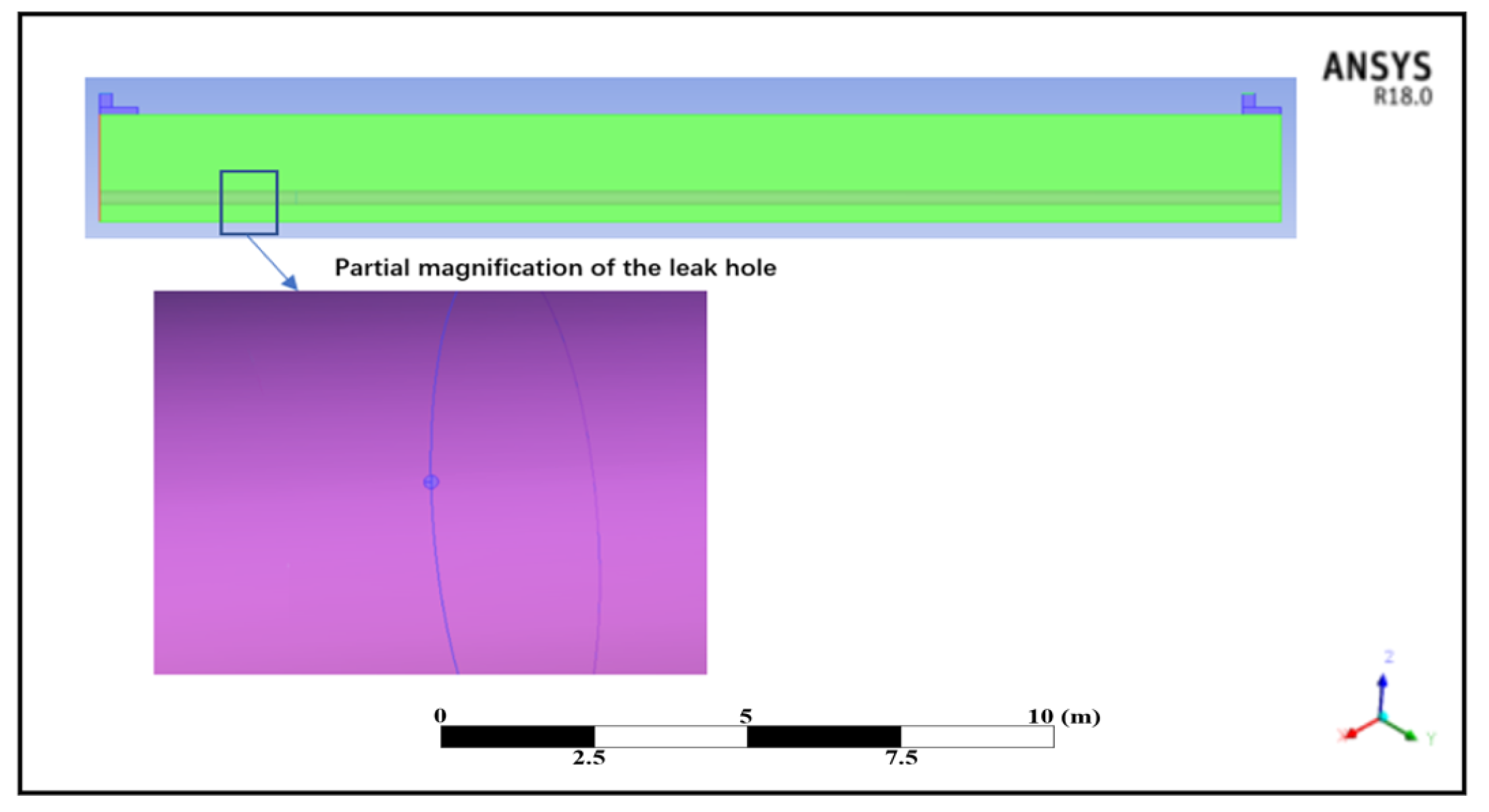
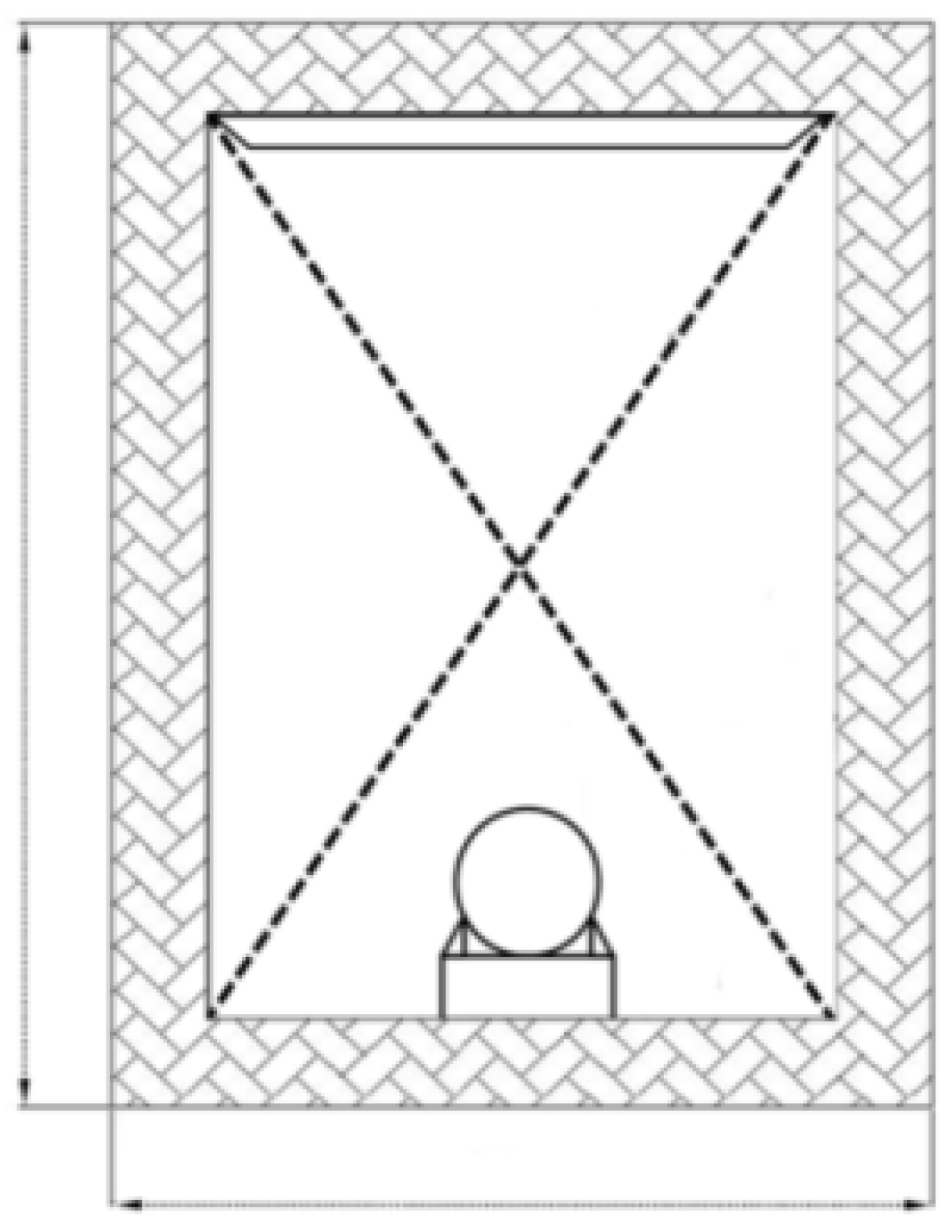
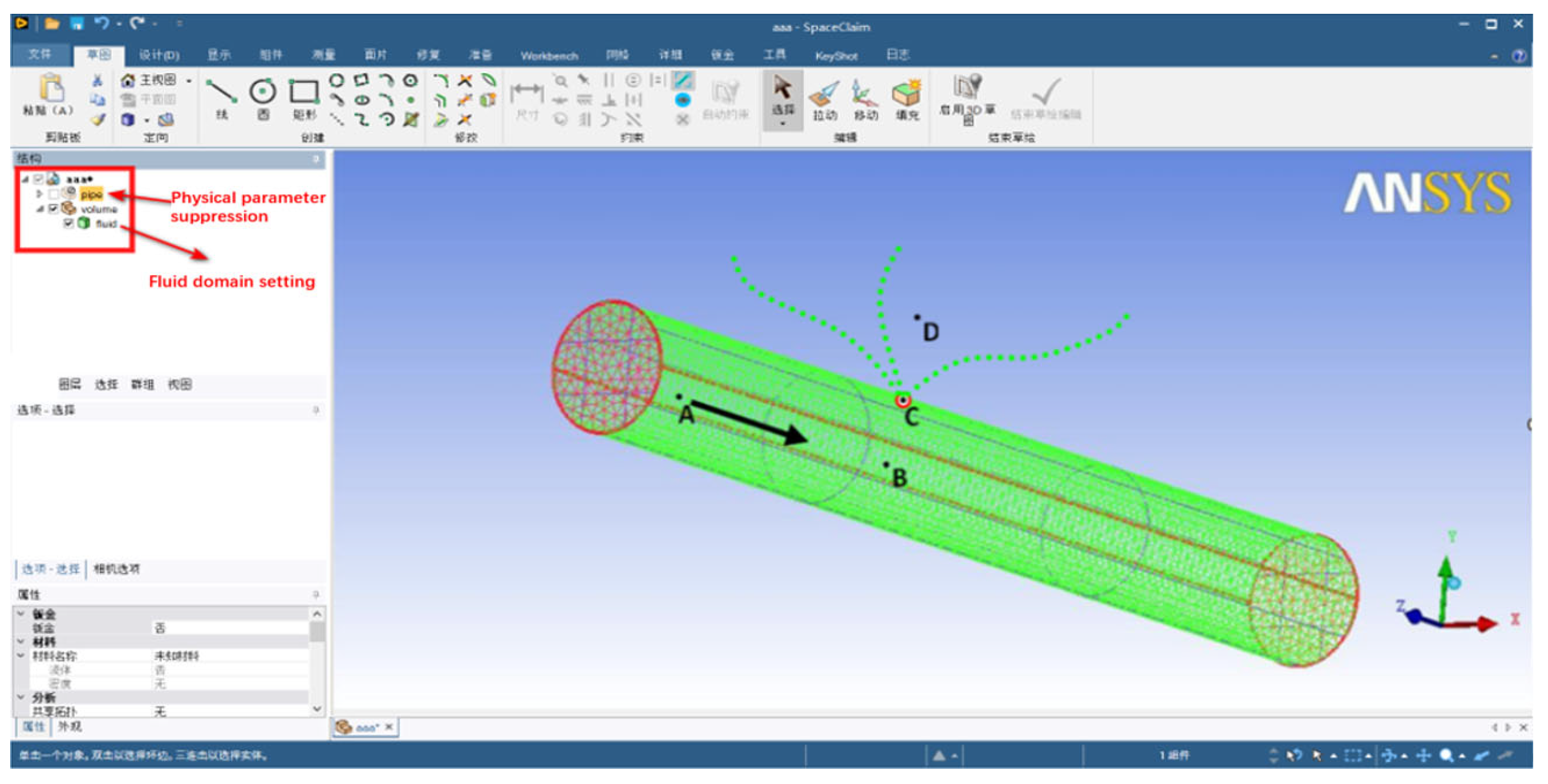

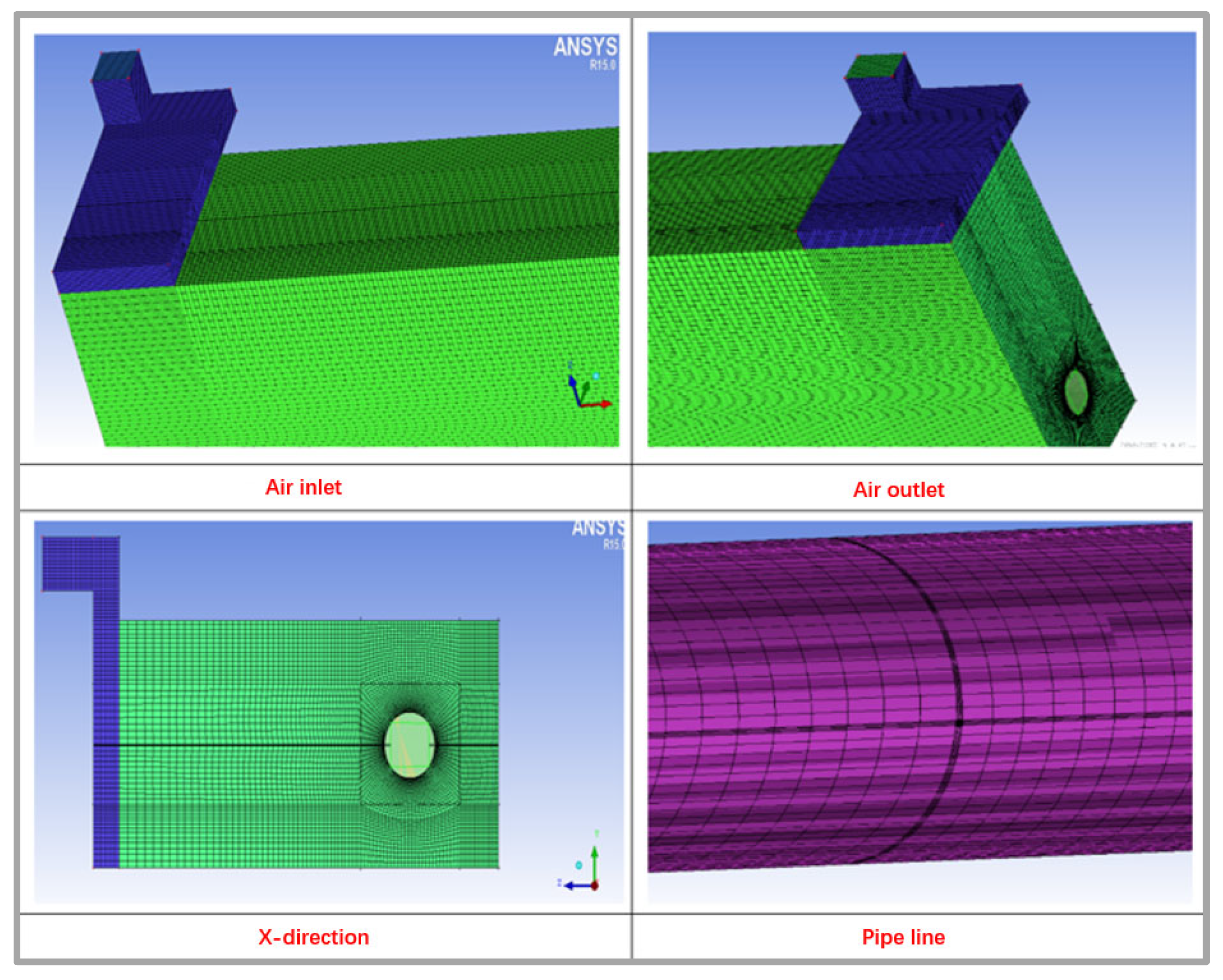
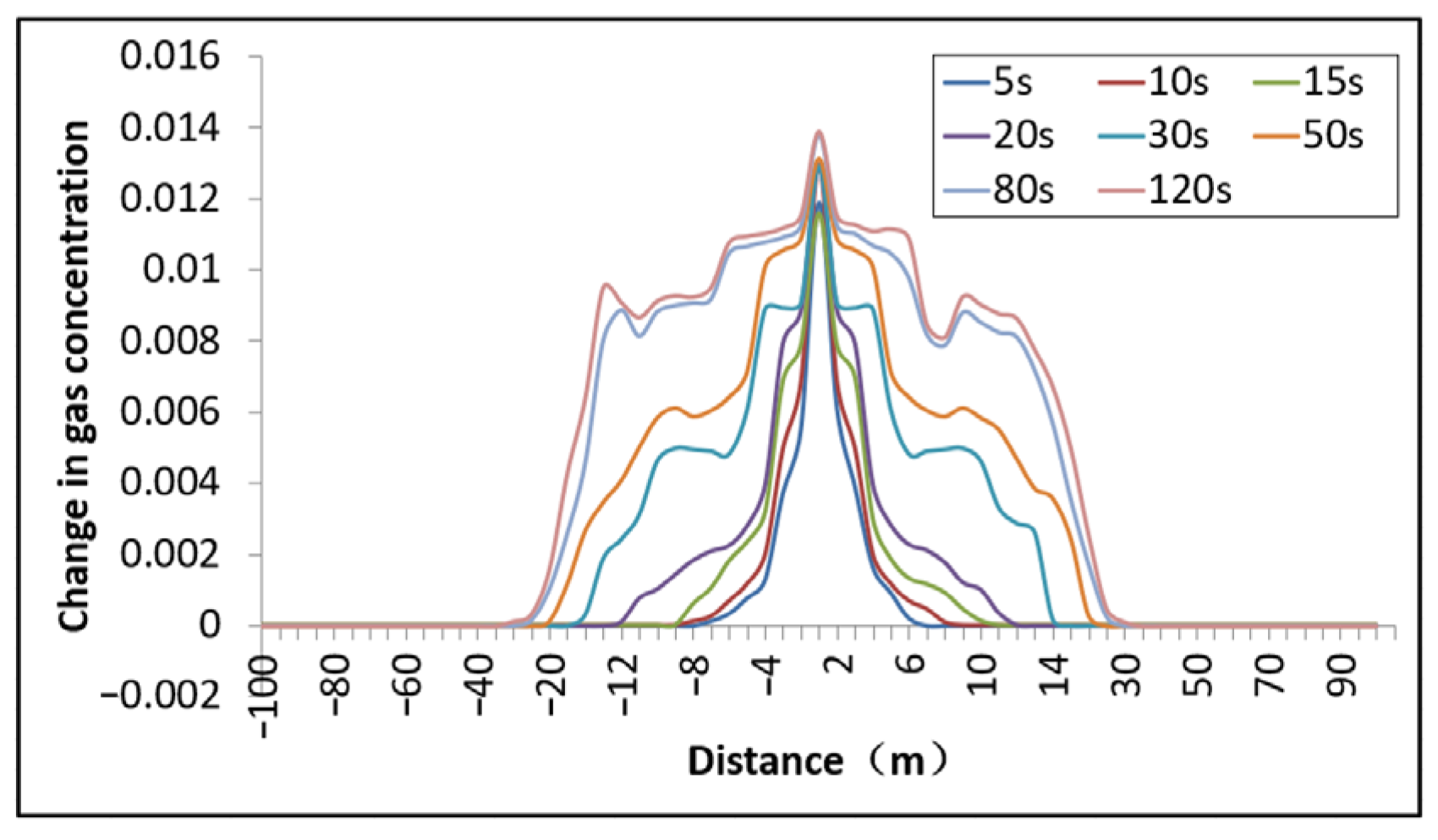

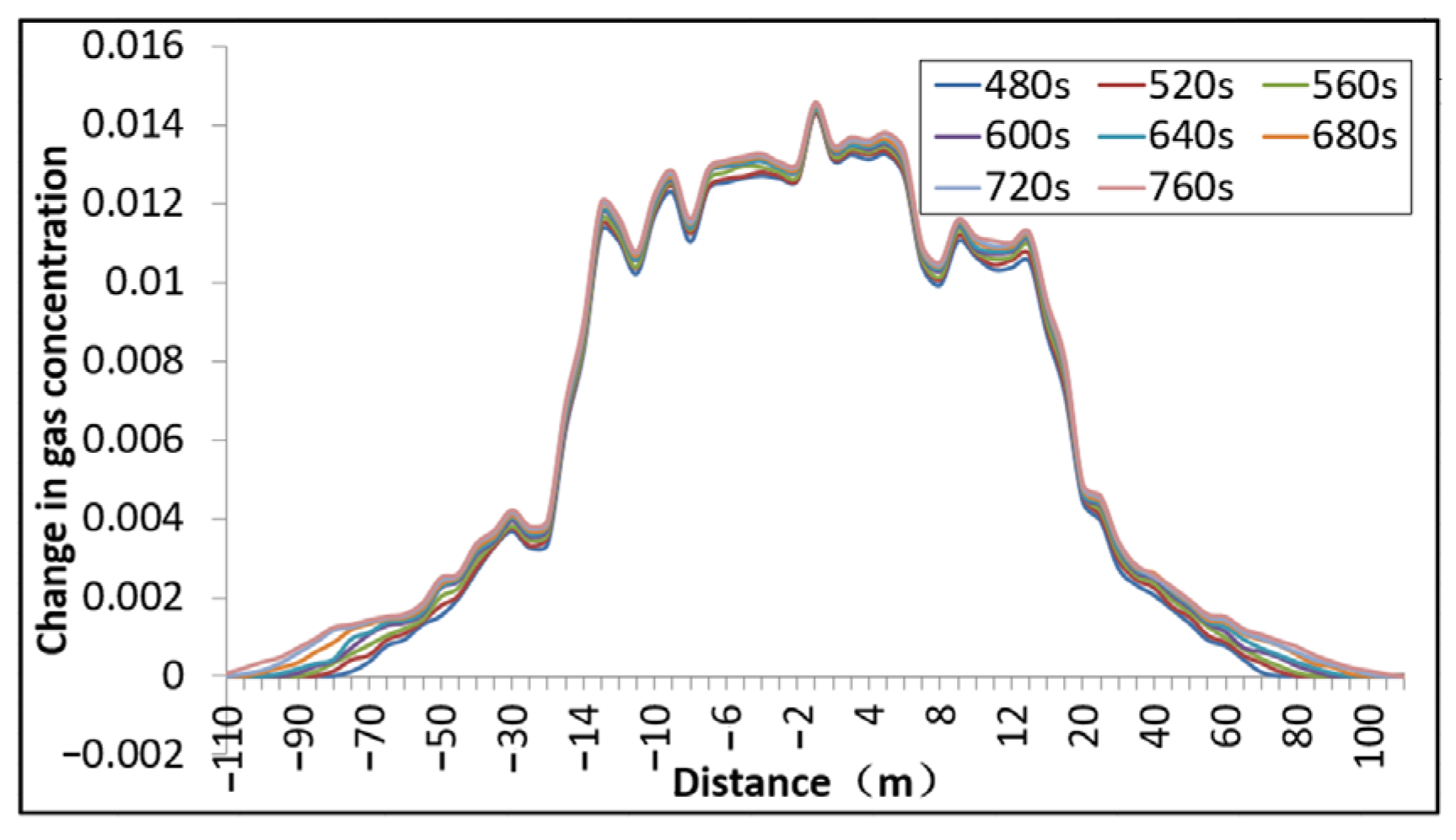
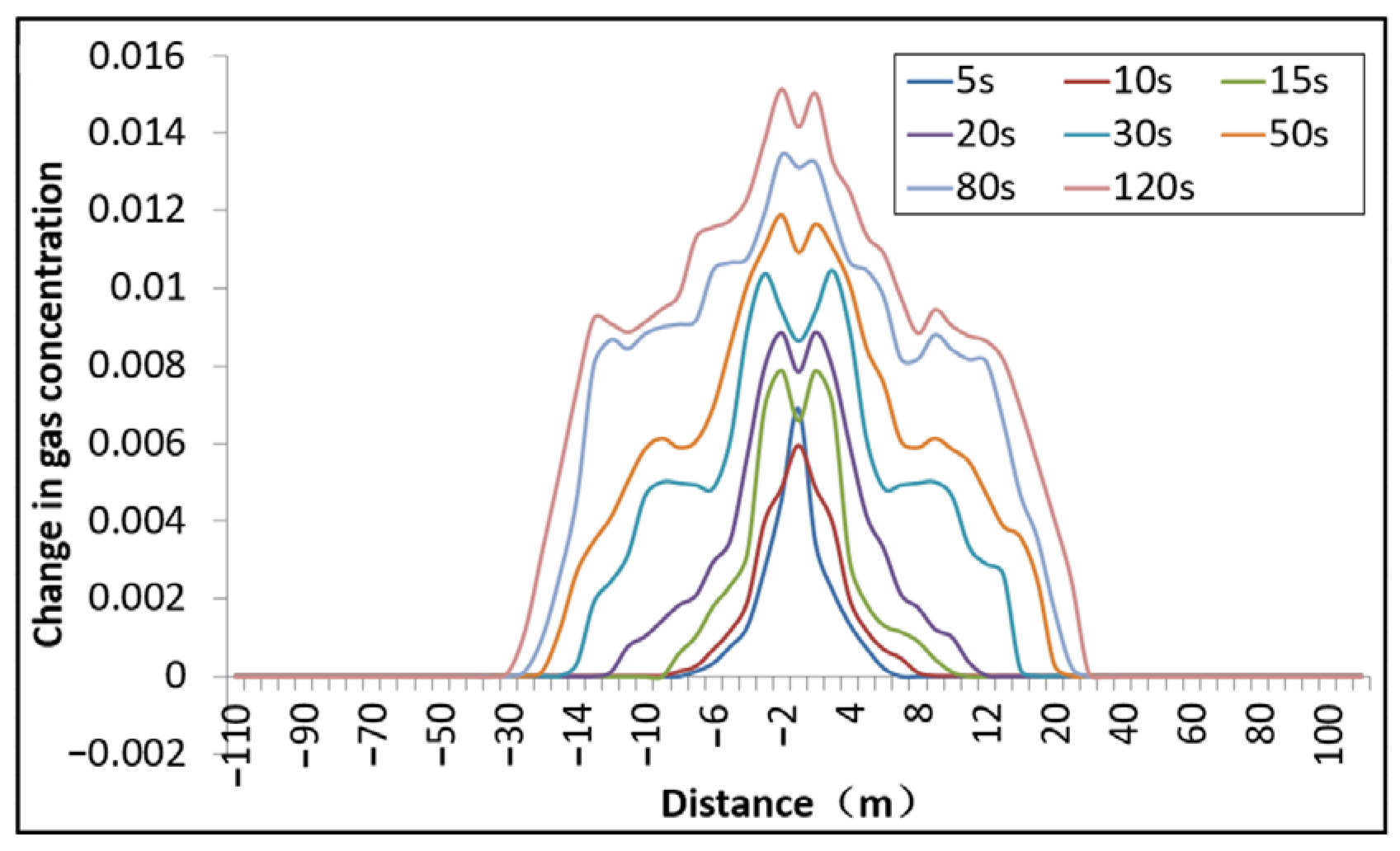

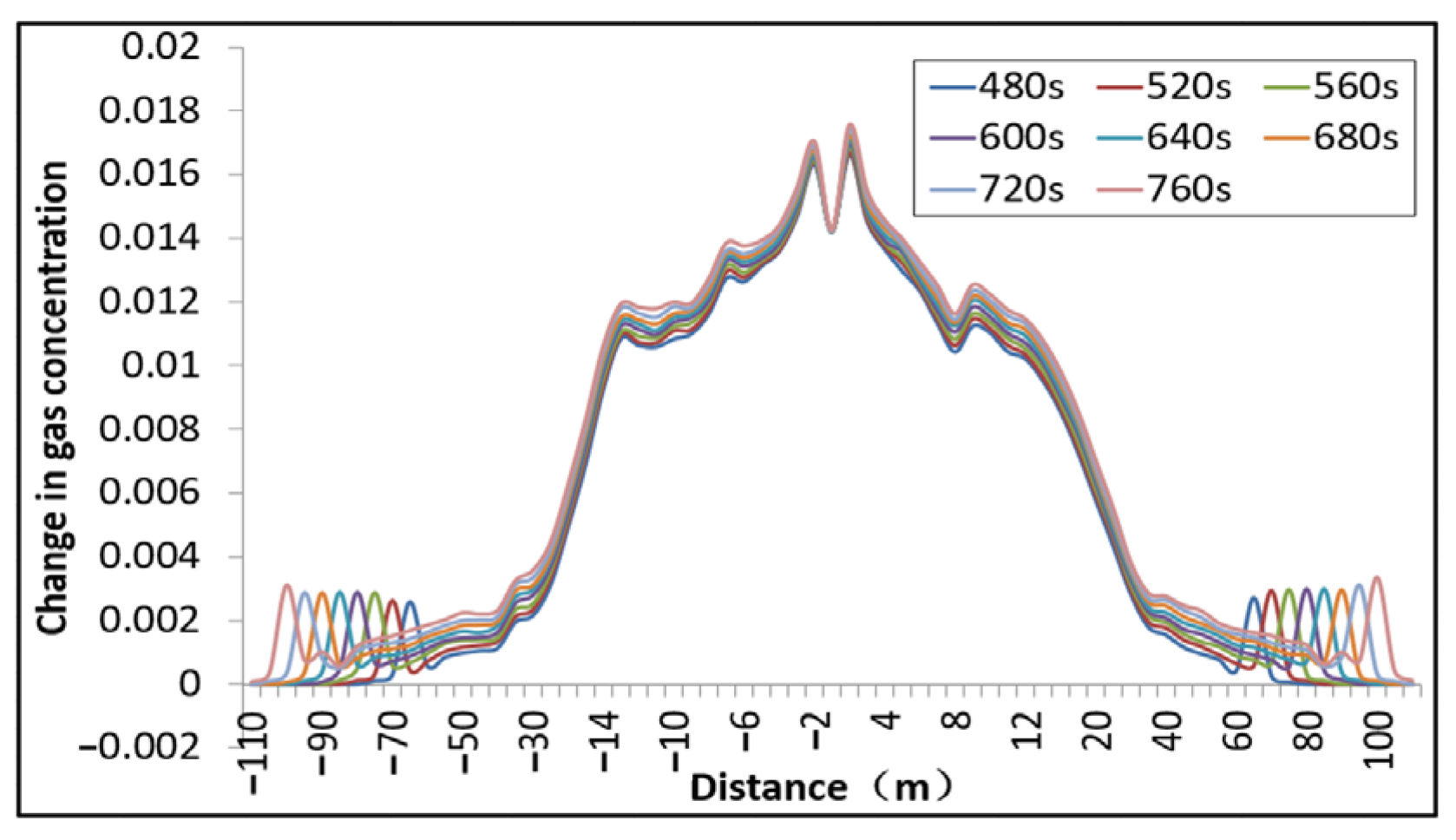
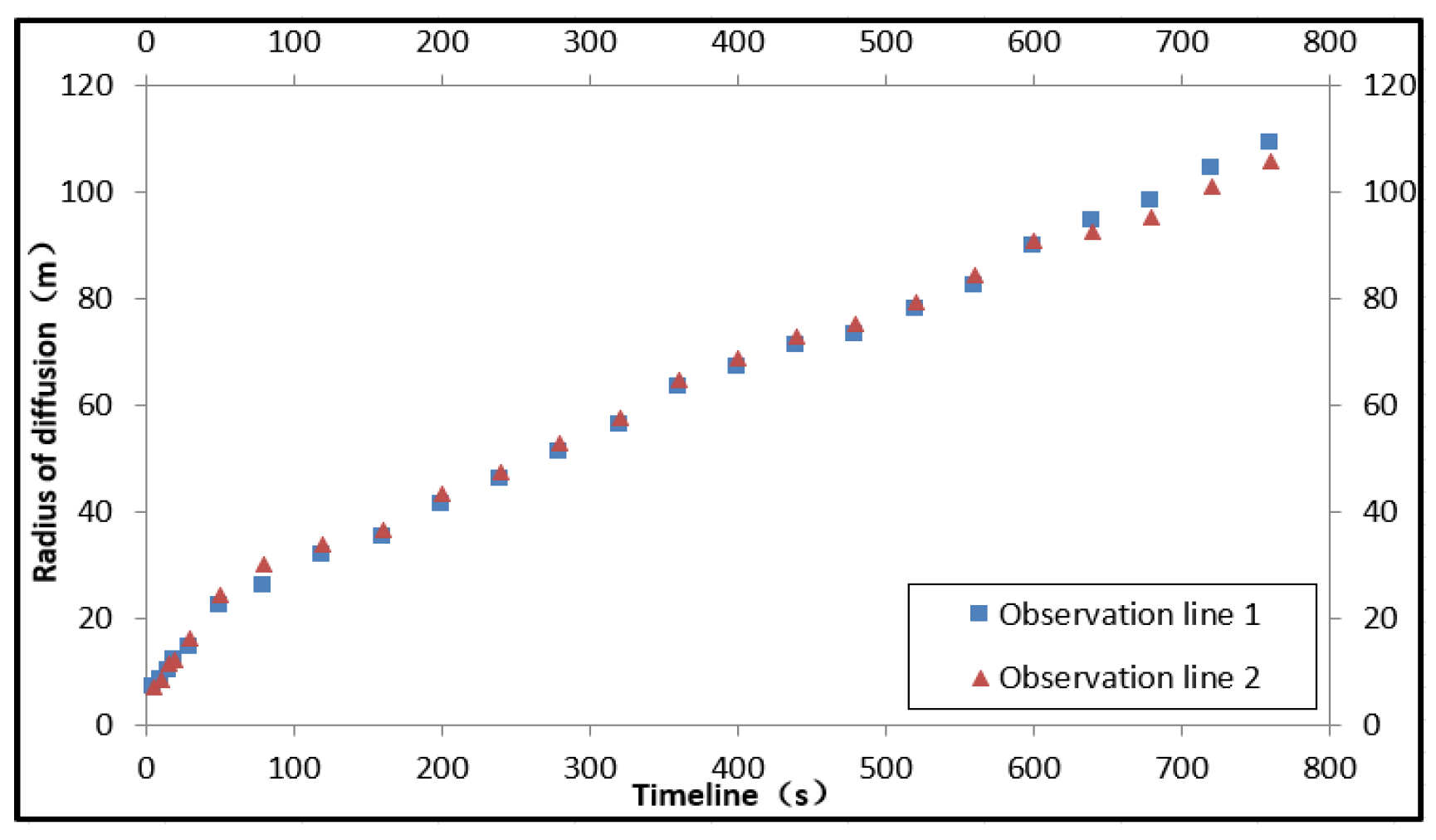
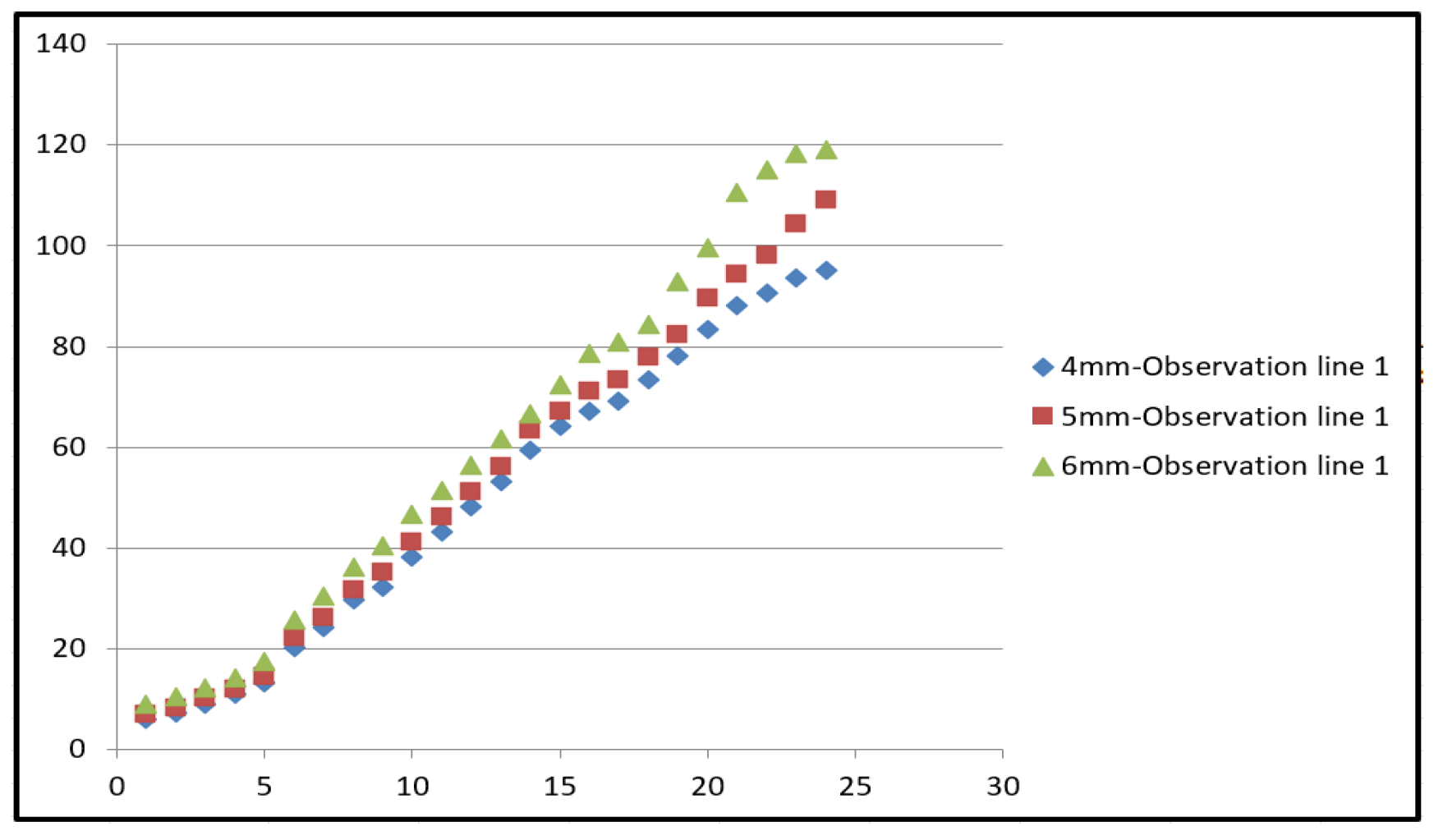
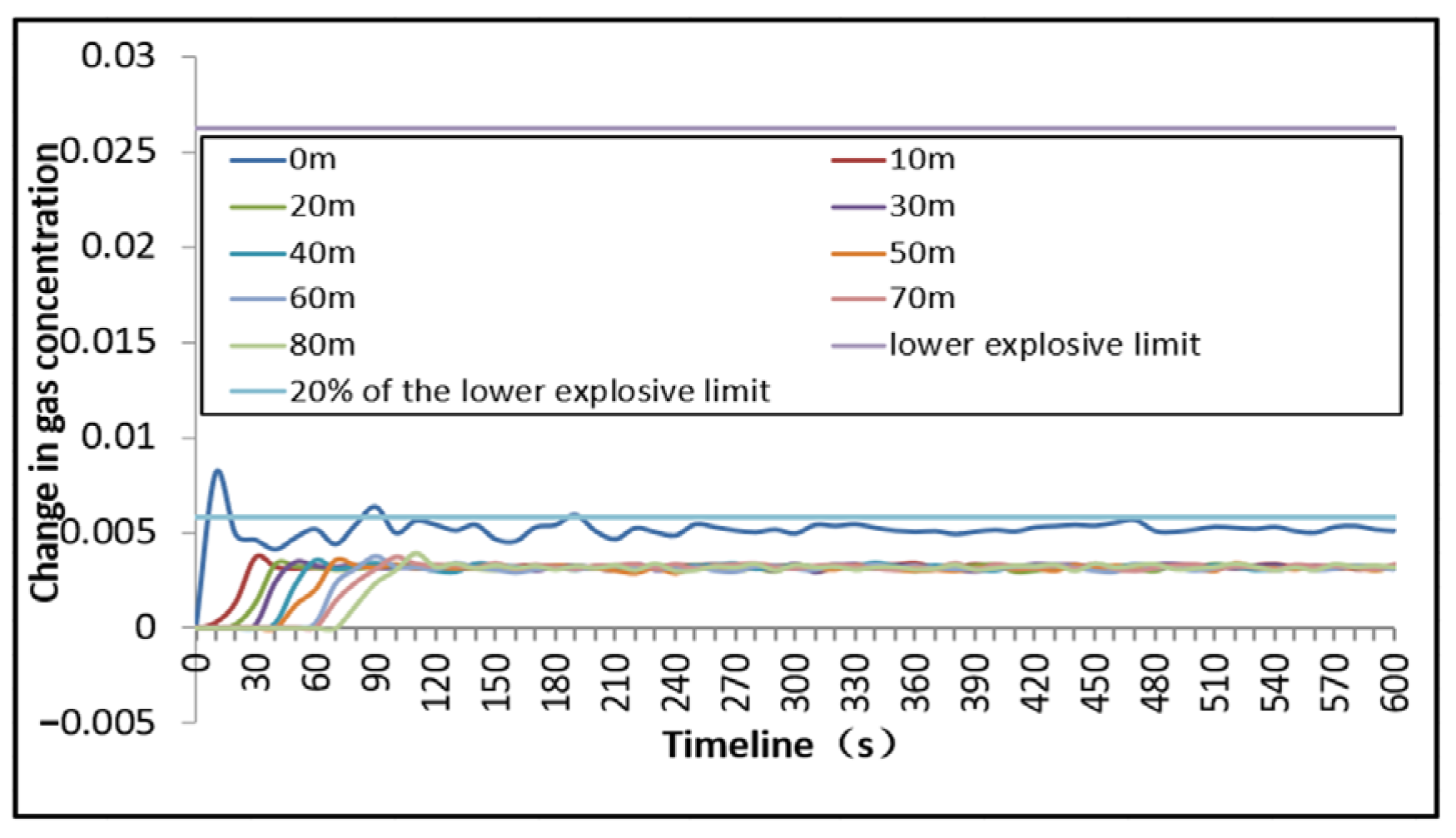
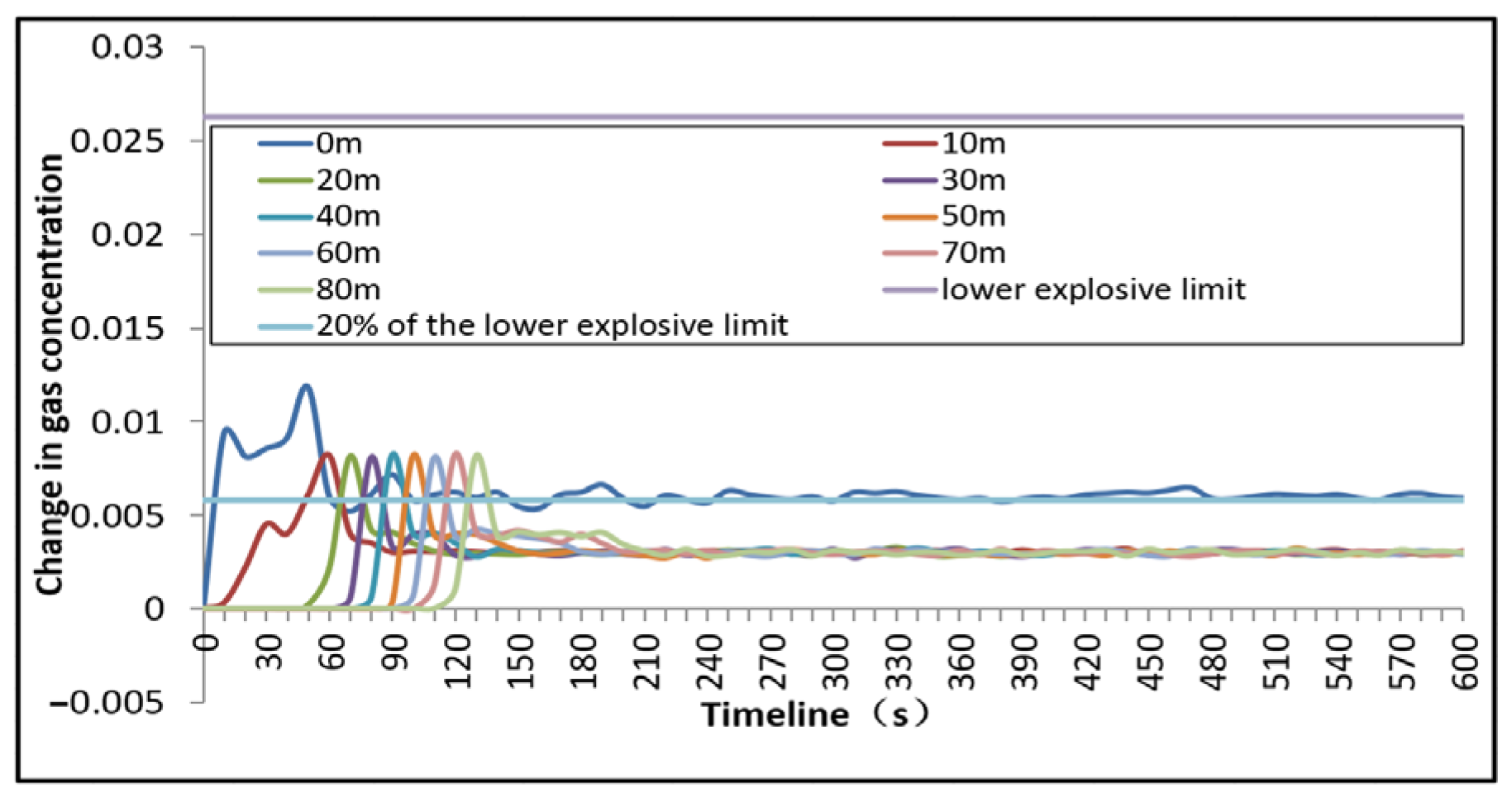

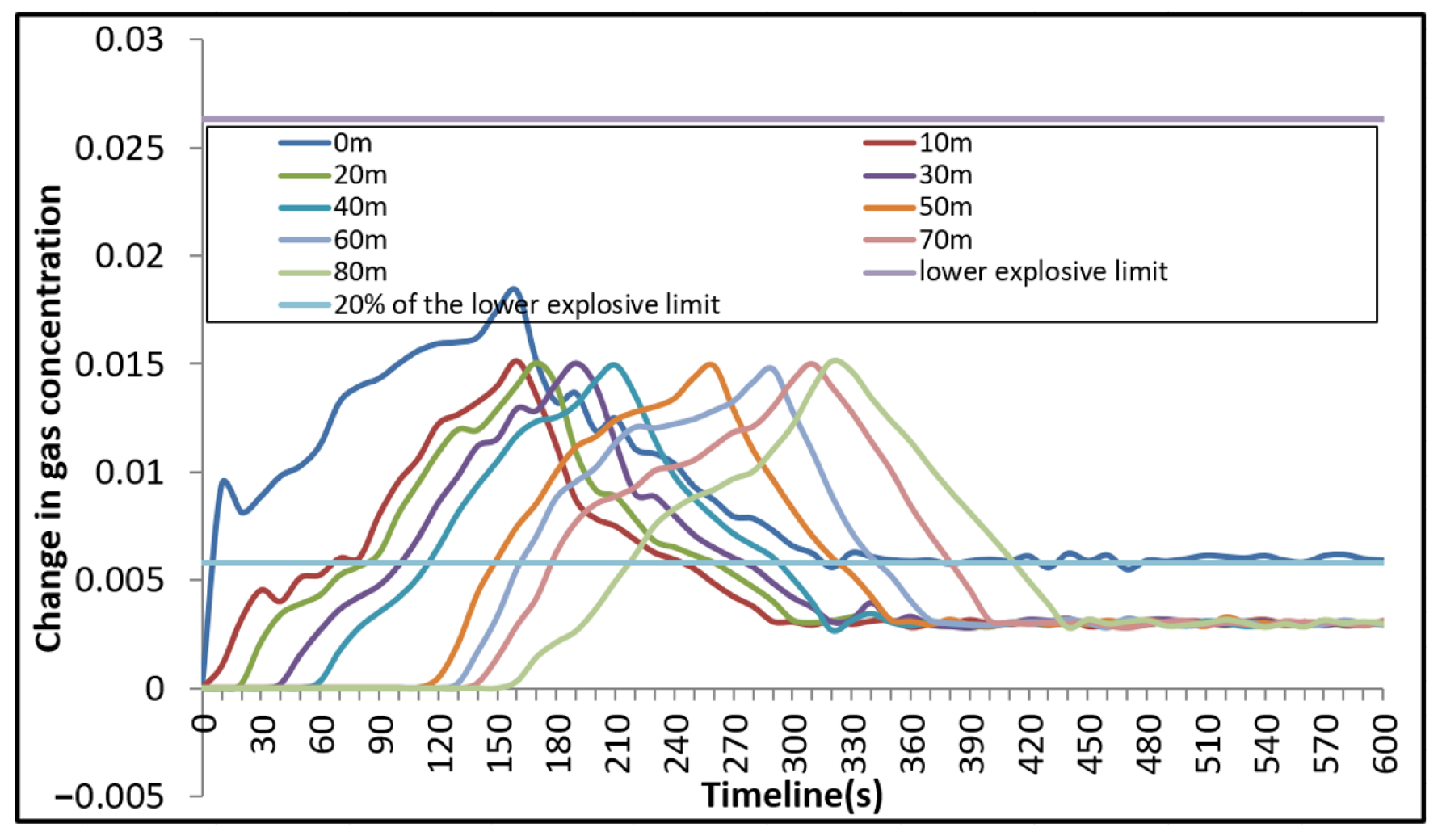
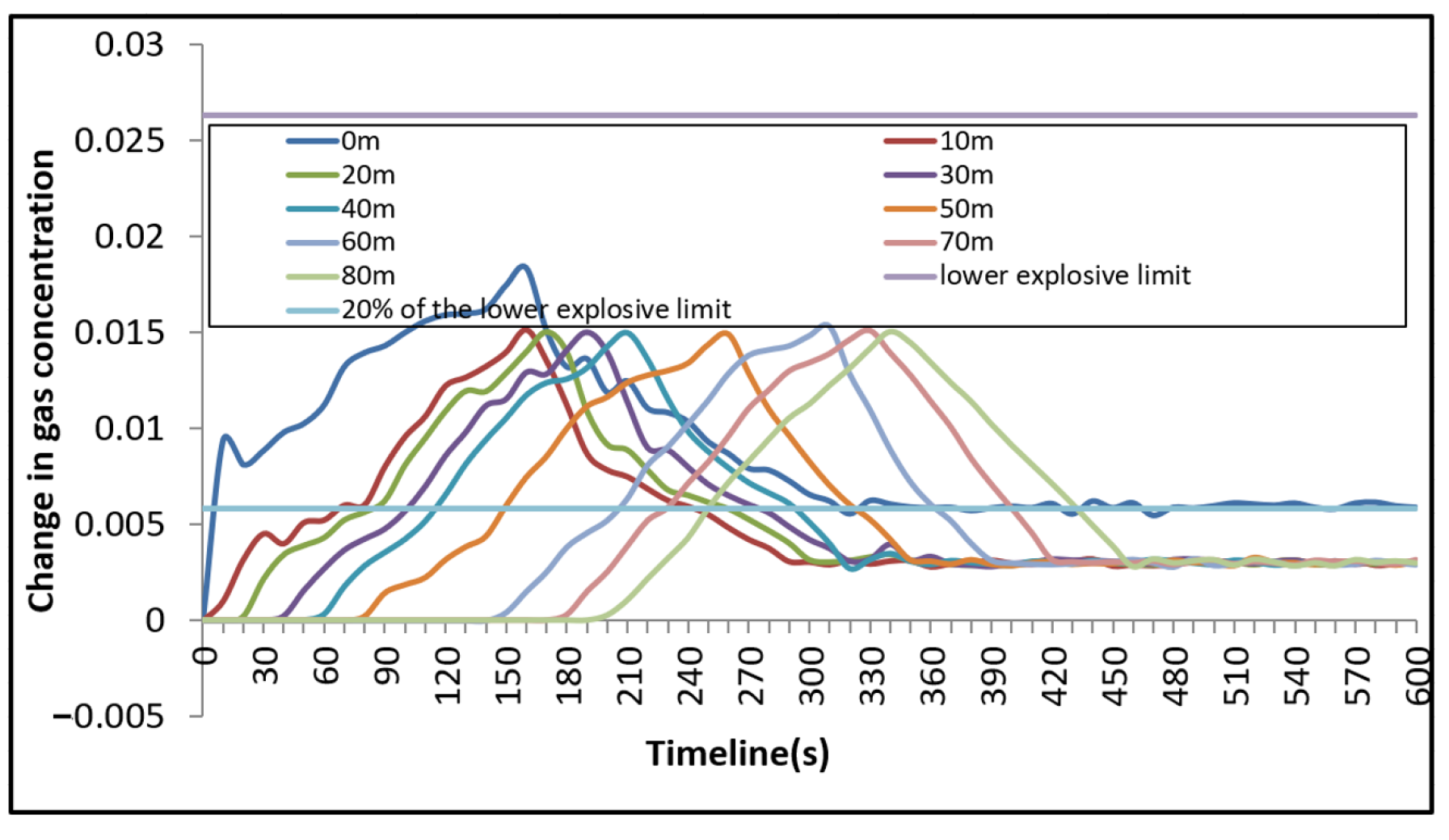

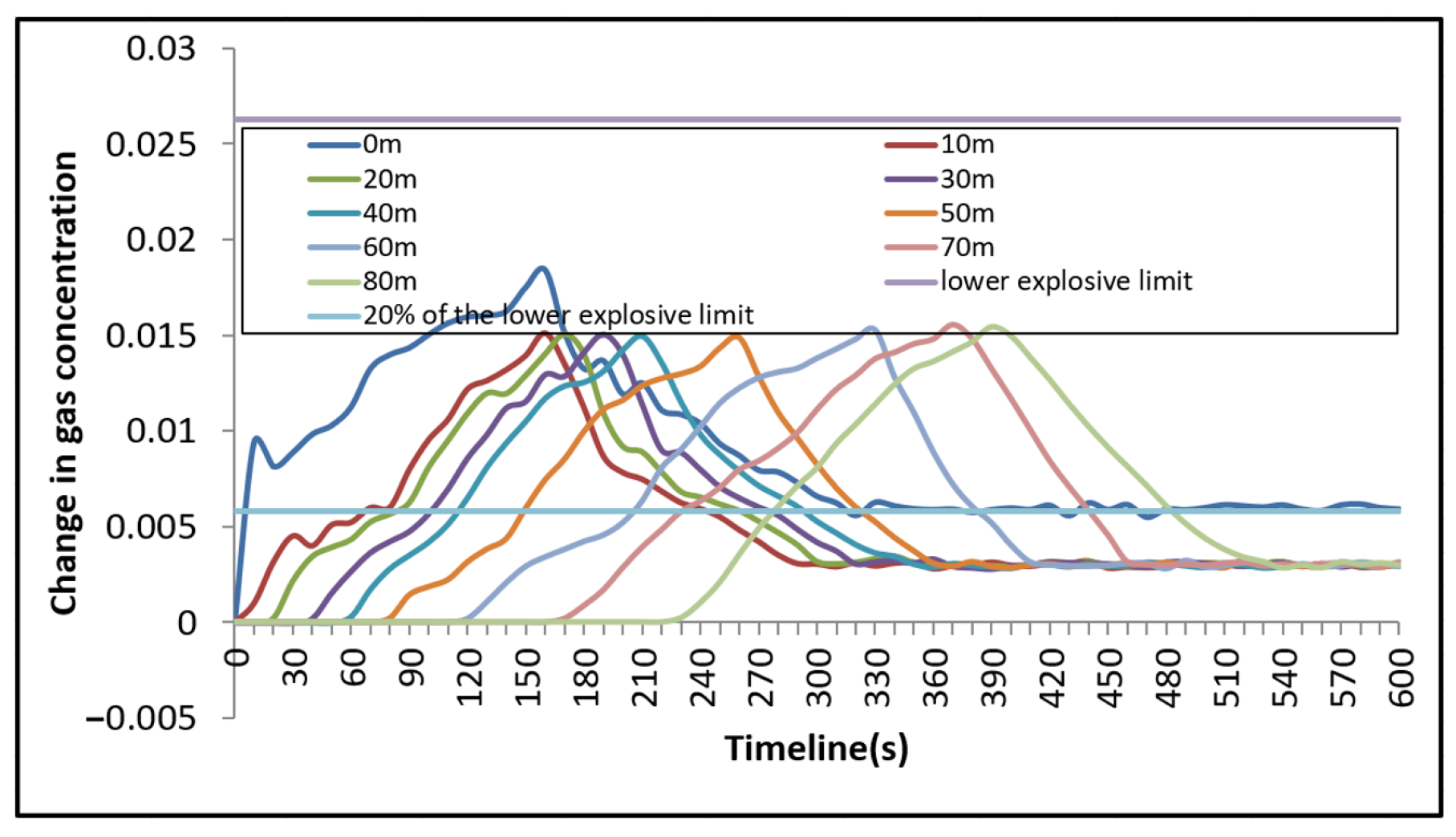
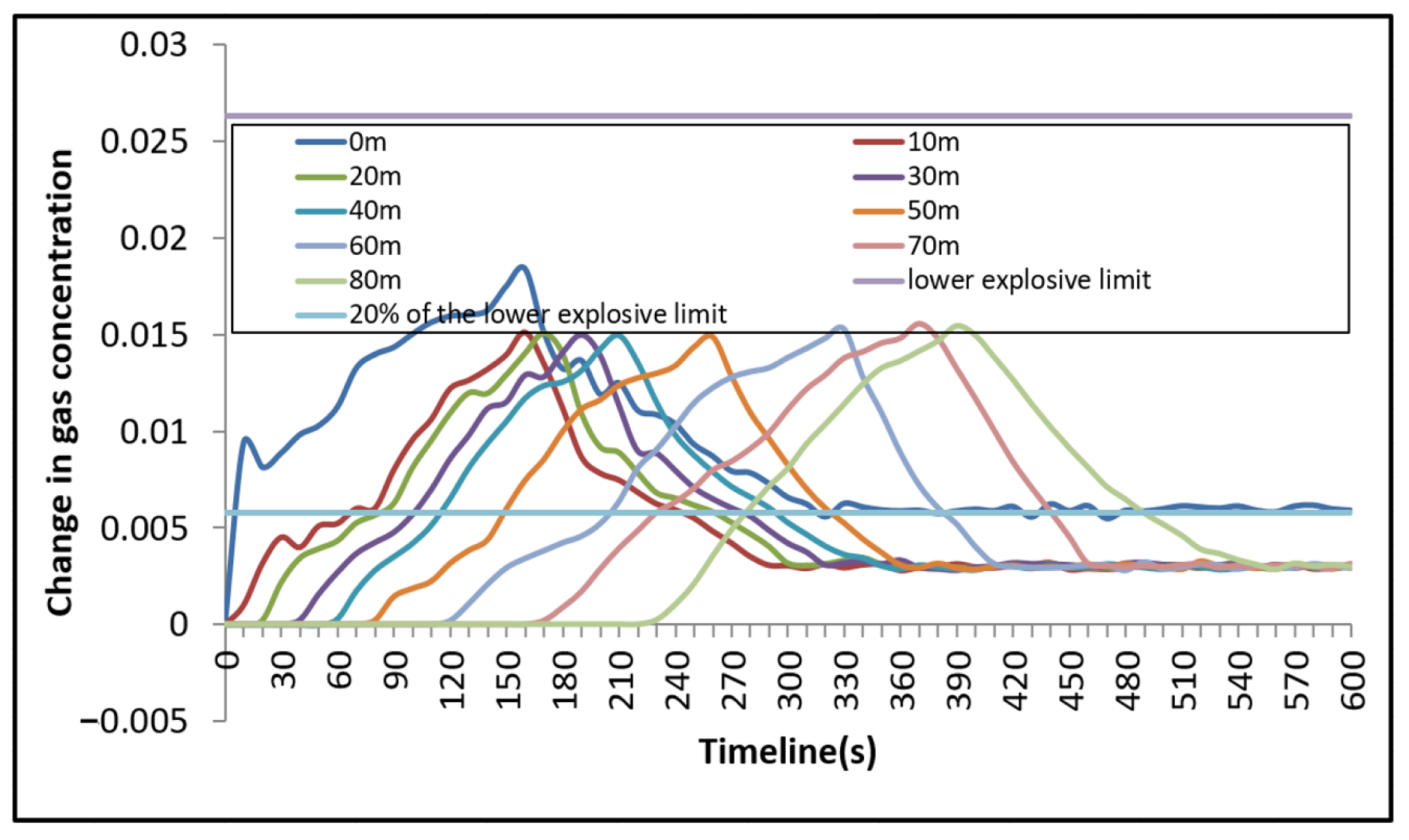


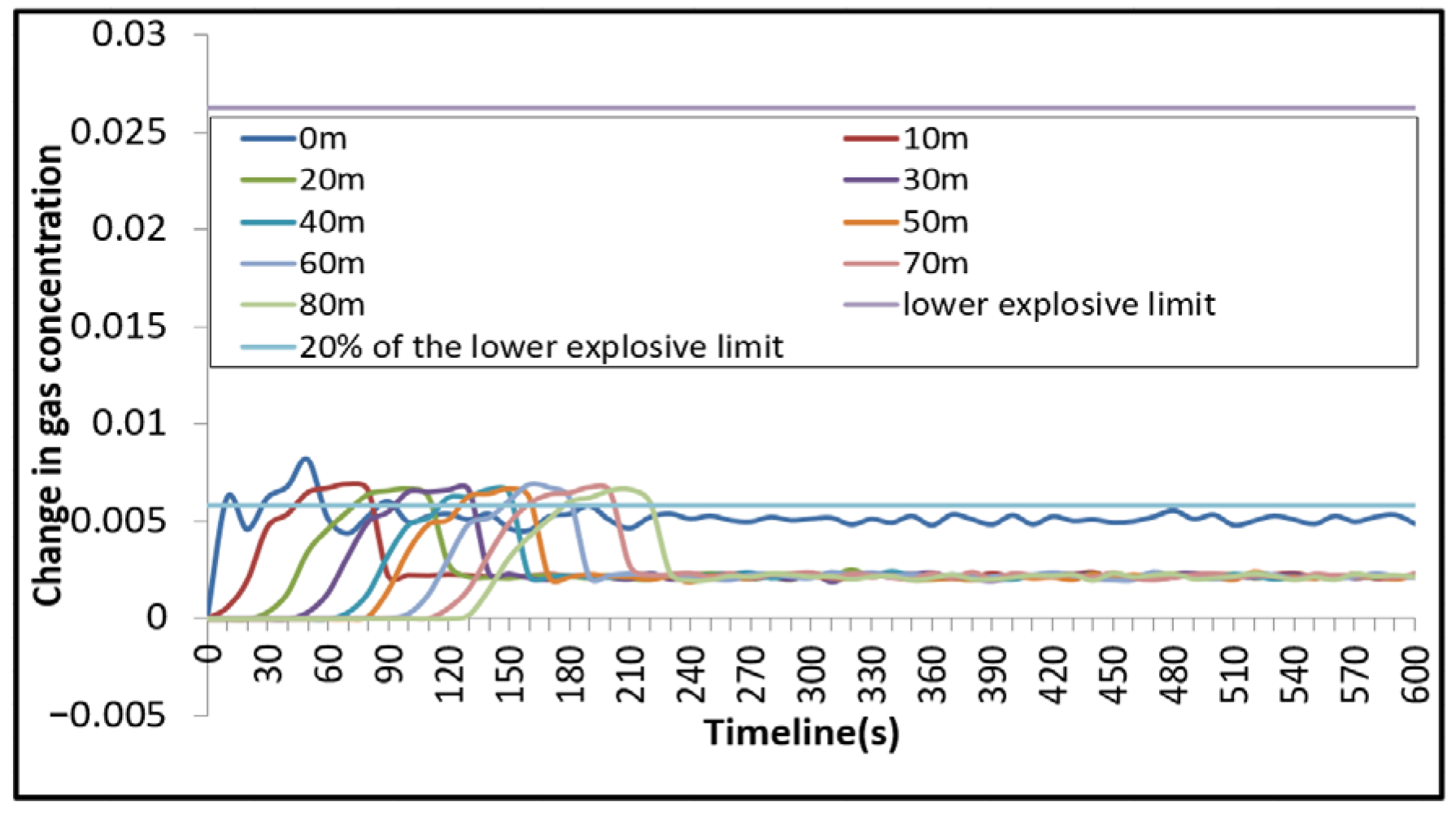
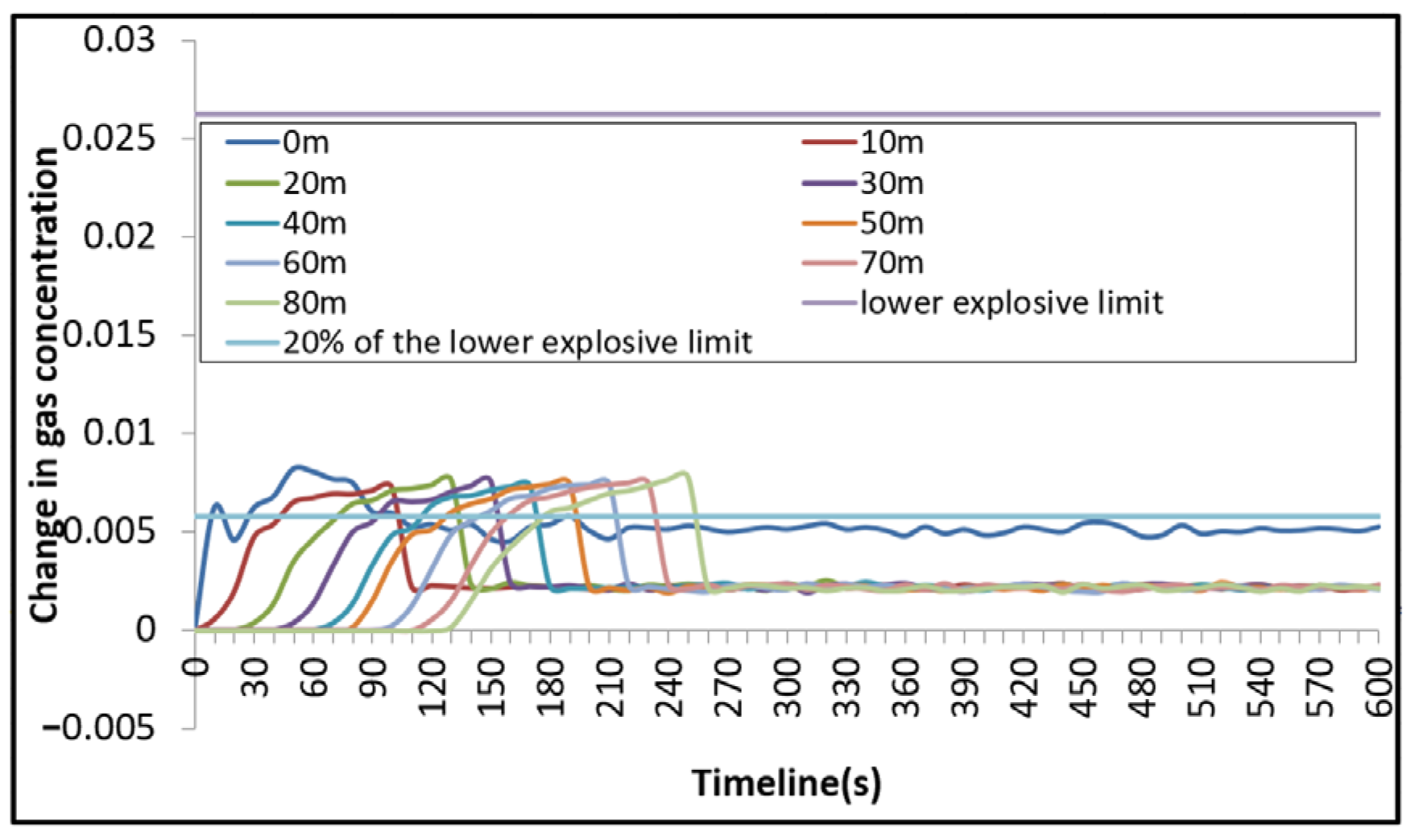
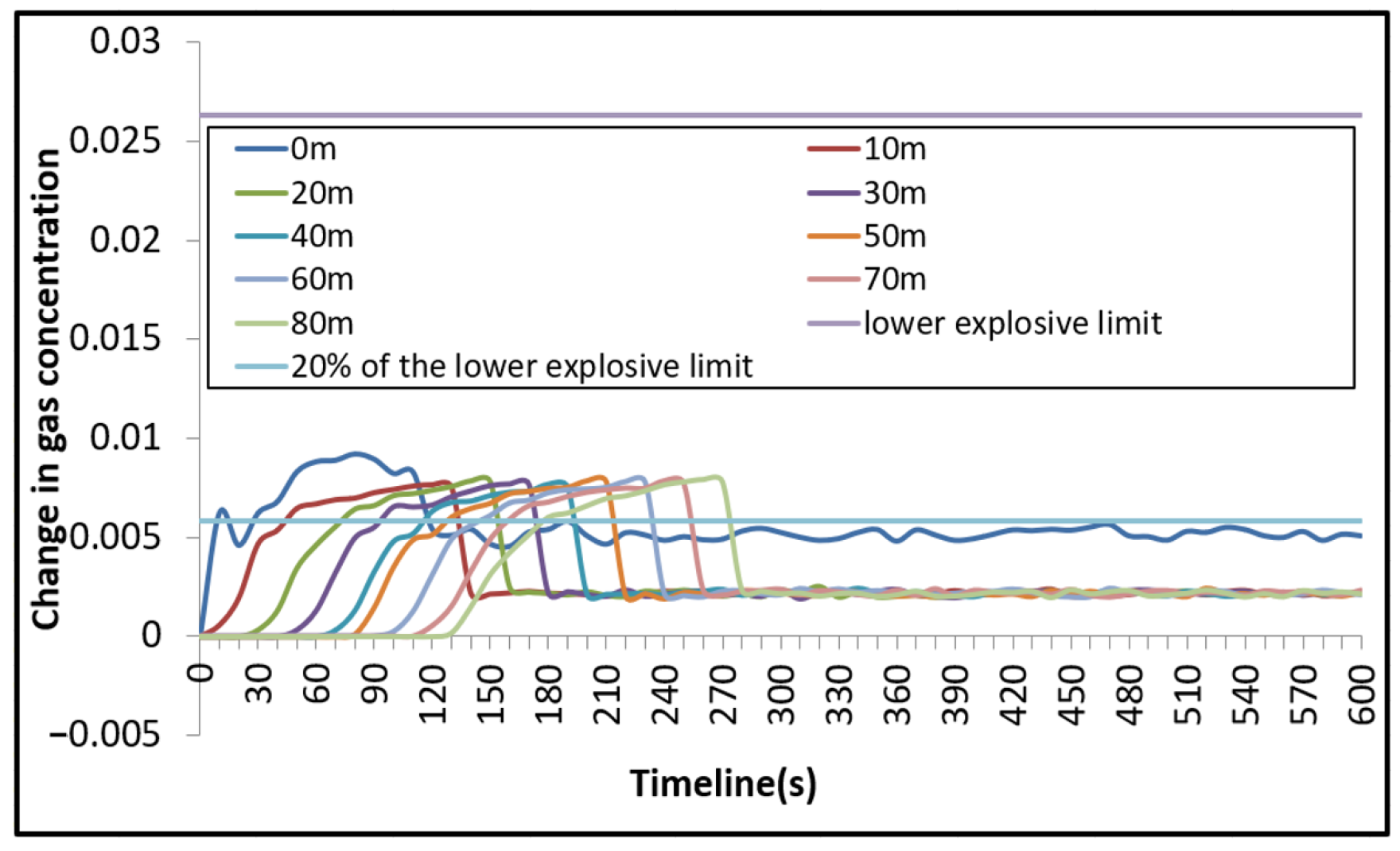
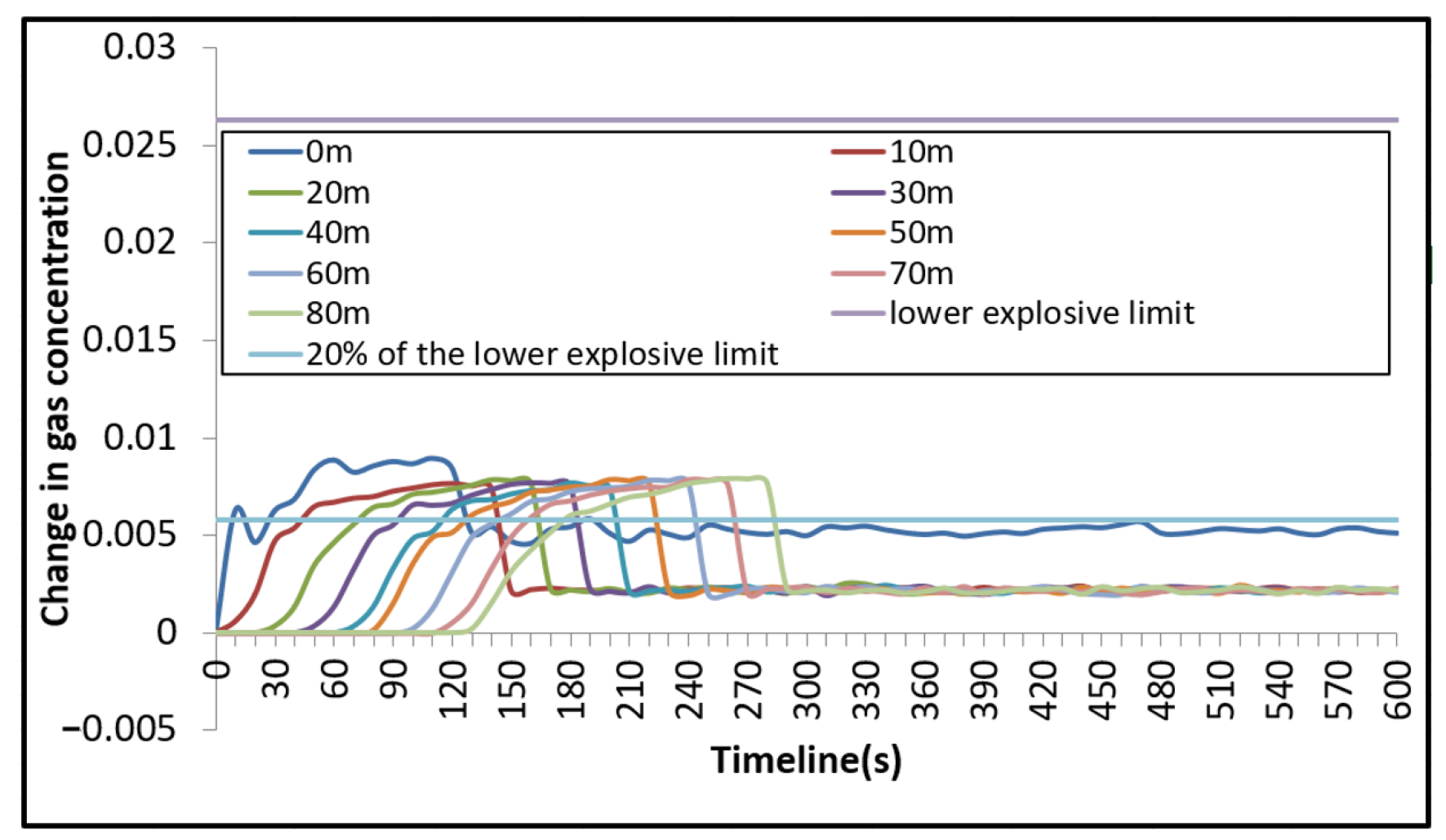

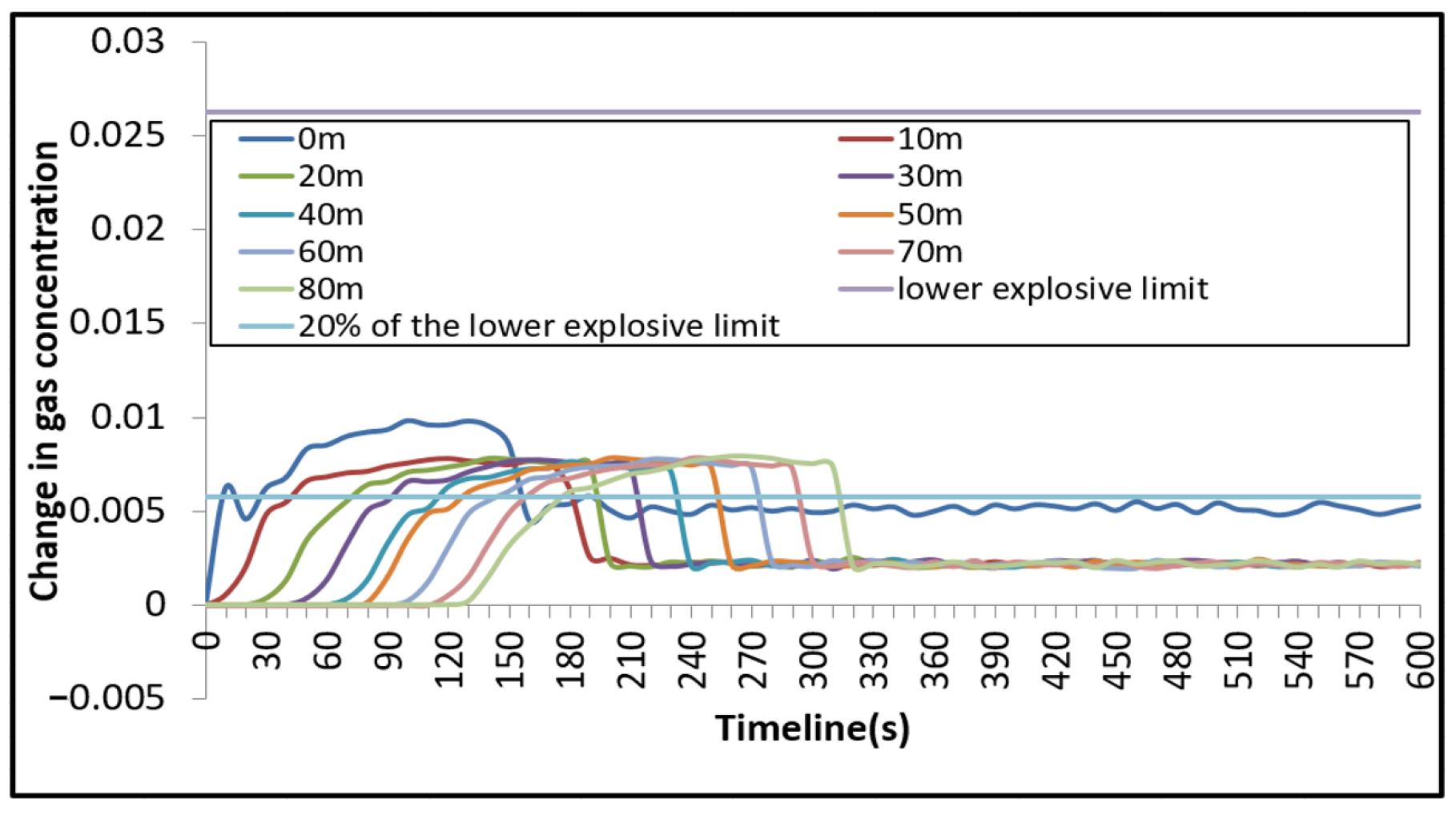
| Number of Grids (Ten Thousands) | Measurement Point 1 | Measurement Point 2 | Measurement Point 3 | Measurement Point 4 | Measurement Point 5 |
|---|---|---|---|---|---|
| 300 | 0.00032654648 | 0.00030545612 | 0.00029123565 | 0.00028804032 | 0.00028013151 |
| 350 | 0.00040125642 | 0.00039254185 | 0.000394517891 | 0.00039568922 | 0.00038421638 |
| 400 | 0.00042356418 | 0.00041287459 | 0.000411428713 | 0.00041284463 | 0.00040924677 |
| 450 | 0.00045532891 | 0.00044612385 | 0.000440136828 | 0.00043136237 | 0.00043017865 |
| 500 | 0.00047241895 | 0.00045279432 | 0.000459637925 | 0.00045516673 | 0.00044372919 |
| 550 | 0.00042155974 | 0.00043090872 | 0.000413533287 | 0.00041987561 | 0.00040765612 |
| 600 | 0.00041326498 | 0.00042115659 | 0.000409794652 | 0.00040331645 | 0.00039532316 |
| 650 | 0.00039561365 | 0.00040021648 | 0.000402164956 | 0.00039231492 | 0.00038398422 |
| 700 | 0.00038765296 | 0.00039316518 | 0.000392326462 | 0.00038469879 | 0.00038203126 |
| 750 | 0.00003745348 | 0.00036494237 | 0.000357956963 | 0.00034659891 | 0.00034377918 |
| No. | Setting Boundaries | Boundary Conditions | Parameter Setting |
|---|---|---|---|
| 1 | Leak port | Entrance of mass outflow | Temperature, Mass flow, Pressure |
| 2 | Fans | Inlet of pressure | Temperature, Wind speed, Ventilation type, Ventilation Time interval, Air pressure |
| 3 | Air outlet mezzanine | Outlet of pressure | Static pressure, Temperature |
| 4 | Pipe wall and inside pipe cabin | Surface boundary | Temperature difference between tube wall and cabin wall, Thermal conductivity, Material type |
| Installation Location (t) | Starting Moment (s) | Unwinding Time (s) | Time Interval (s) |
|---|---|---|---|
| 0 m | 0 | 0 | 0 |
| 10 m | 0 | 0 | 0 |
| 20 m | 72.3 | 224.4 | 152.1 |
| 30 m | 43.2 | 257.1 | 213.9 |
| 40 m | 44.5 | 276.3 | 231.8 |
| 50 m | 45.1 | 287.5 | 242.4 |
| 60 m | 45.8 | 303.7 | 257.9 |
| 70 m | 46.2 | 314.5 | 268.3 |
Disclaimer/Publisher’s Note: The statements, opinions and data contained in all publications are solely those of the individual author(s) and contributor(s) and not of MDPI and/or the editor(s). MDPI and/or the editor(s) disclaim responsibility for any injury to people or property resulting from any ideas, methods, instructions or products referred to in the content. |
© 2023 by the authors. Licensee MDPI, Basel, Switzerland. This article is an open access article distributed under the terms and conditions of the Creative Commons Attribution (CC BY) license (https://creativecommons.org/licenses/by/4.0/).
Share and Cite
Wang, R.; Zhang, Z.; Gong, D. Simulation Study on Gas Leakage Law and Early Warning in a Utility Tunnel. Sustainability 2023, 15, 15375. https://doi.org/10.3390/su152115375
Wang R, Zhang Z, Gong D. Simulation Study on Gas Leakage Law and Early Warning in a Utility Tunnel. Sustainability. 2023; 15(21):15375. https://doi.org/10.3390/su152115375
Chicago/Turabian StyleWang, Ru, Zhenji Zhang, and Daqing Gong. 2023. "Simulation Study on Gas Leakage Law and Early Warning in a Utility Tunnel" Sustainability 15, no. 21: 15375. https://doi.org/10.3390/su152115375
APA StyleWang, R., Zhang, Z., & Gong, D. (2023). Simulation Study on Gas Leakage Law and Early Warning in a Utility Tunnel. Sustainability, 15(21), 15375. https://doi.org/10.3390/su152115375





